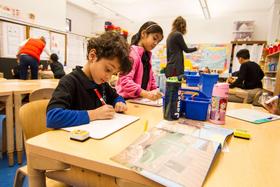Top Rankings
Bridgewater-Raritan Regional School District ranks among the top 20% of public school district in New Jersey for:
Category
Attribute
Science Proficiency
Highest science proficiency (Top 20%)
Diversity
Most diverse schools (Top 1%)
Community Size
Largest student body (number of students) (Top 1%)
For the 2025-26 school year, there is 1 public high school serving 2,745 students in Bridgewater-Raritan Regional School District. This district's average high testing ranking is 9/10, which is in the top 20% of public high schools in New Jersey.
Public High School in Bridgewater-Raritan Regional School District have an average math proficiency score of 52% (versus the New Jersey public high school average of 29%), and reading proficiency score of 61% (versus the 47% statewide average).
Public High School in Bridgewater-Raritan Regional School District have a Graduation Rate of 92%, which is more than the New Jersey average of 91%.
The school with highest graduation rate is Bridgewater-raritan High School, with 92% graduation rate. Read more about public school graduation rate statistics in New Jersey or national school graduation rate statistics.
Minority enrollment is 58% of the student body (majority Asian), which is less than the New Jersey public high school average of 63% (majority Hispanic).
Overview
This School District
This State (NJ)
# Schools
11 Schools
548 Schools
# Students
7,912 Students
467,298 Students
# Teachers
714 Teachers
36,806 Teachers
Student-Teacher Ratio
11:1
11:1
Student By Grade
District Rank
Bridgewater-Raritan Regional School District, which is ranked within the top 30% of all 645 school districts in New Jersey (based off of combined math and reading proficiency testing data) for the 2022-2023 school year.
The school district's graduation rate of 92% has decreased from 95% over five school years.
Overall District Rank
#158 out of 648 school districts
(Top 30%)
(Top 30%)
Math Test Scores (% Proficient)
54%
38%
Reading/Language Arts Test Scores (% Proficient)
65%
49%
Science Test Scores (% Proficient)
39%
23%
Graduation Rate
92%
85%
Students by Ethnicity:
Diversity Score
0.70
0.72
% American Indian
n/a
n/a
% Asian
31%
10%
% Hispanic
20%
34%
% Black
4%
17%
% White
41%
37%
% Hawaiian
n/a
n/a
% Two or more races
4%
2%
All Ethnic Groups
District Revenue and Spending
The revenue/student of $25,865 in this school district is less than the state median of $26,937. The school district revenue/student has stayed relatively flat over four school years.
The school district's spending/student of $24,481 is less than the state median of $25,834. The school district spending/student has stayed relatively flat over four school years.
Total Revenue
$205 MM
$36,642 MM
Spending
$194 MM
$35,142 MM
Revenue / Student
$25,865
$26,937
Spending / Student
$24,481
$25,834
Best Bridgewater-Raritan Regional School District Public High Schools (2025-26)
School
(Math and Reading Proficiency)
(Math and Reading Proficiency)
Location
Quick Facts
Rank: #11.
Bridgewater-raritan High School
(Math: 52% | Reading: 61%)
Rank:
Rank:
7/
Top 50%10
600 Garretson Road
Bridgewater, NJ 08807
(908) 231-8660
Bridgewater, NJ 08807
(908) 231-8660
Gr: 9-12 | 2,745 students Student-teacher ratio: 13:1 Minority enrollment: 58%
Recent Articles

Bullying, Name-Calling & Put-Downs: Parent Guide 2025
Practical tips for parents to address bullying, name-calling, and put-downs鈥攚ith 2025 data, policies, and expert strategies.

What Is a Magnet School? (2025 Guide)
Explore what a magnet school is, how it works, and its benefits in 2025. Clear explanation for parents, students, and educators.

Cooperative Learning in 2025: Evidence, Best Practices & Challenges
Explore cooperative learning in 2025鈥攏ew data, updated practices, expert insights for educators and families.





